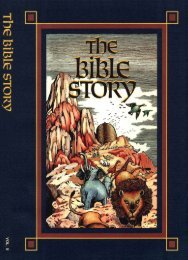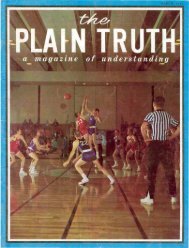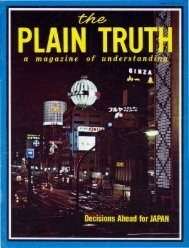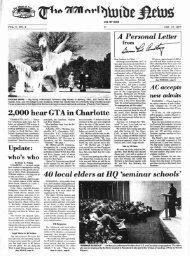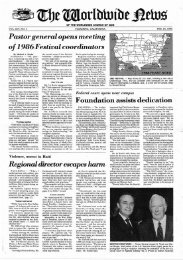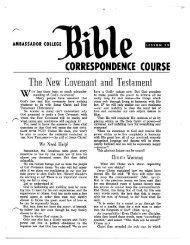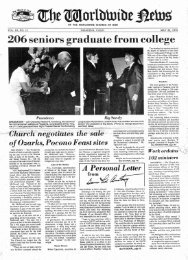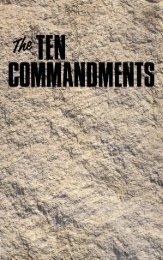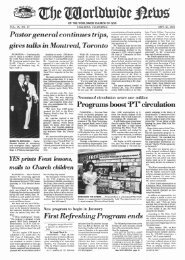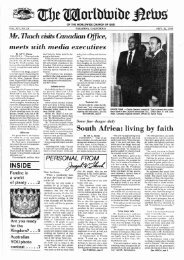Crucifixion Was Not on Friday (1968)_b.pdf - Herbert W. Armstrong
Crucifixion Was Not on Friday (1968)_b.pdf - Herbert W. Armstrong
Crucifixion Was Not on Friday (1968)_b.pdf - Herbert W. Armstrong
Create successful ePaper yourself
Turn your PDF publications into a flip-book with our unique Google optimized e-Paper software.
The <str<strong>on</strong>g>Crucifixi<strong>on</strong></str<strong>on</strong>g> <str<strong>on</strong>g>Was</str<strong>on</strong>g> <str<strong>on</strong>g>Not</str<strong>on</strong>g> <strong>on</strong> <strong>Friday</strong> 13<br />
that both of these renderings use the singular - Sabbath. But<br />
in the original Greek the word is in the PLURAL. Fent<strong>on</strong> renders<br />
it correctly by saying, "After the Sabbaths." In a footnote to<br />
this text, he says, "The Greek original is in the plural. 'Sabbaths'<br />
" - which all the scholars should know!<br />
Another verse causing the Bible apparently to c<strong>on</strong>tradict<br />
itself is found in Mark 16:9. Open your Bible to this verse. This<br />
verse does not prove the resurrecti<strong>on</strong> was <strong>on</strong> Sunday. In the<br />
comm<strong>on</strong> versi<strong>on</strong>s, the comma is placed following the word<br />
"week," making it appear that J esus arose <strong>on</strong> Sunday morning.<br />
But the use of commas in the Bible did nut develop until about<br />
fourteen centuries after this was written.<br />
Here is the explanati<strong>on</strong>.<br />
In the original Greek the phrase "early the first day of<br />
the week" can be grammatically c<strong>on</strong>nected either with the words<br />
"having risen" or with the words "He appeared first to Mary<br />
Magdalene." The Expositor's Greek Testament says the phrase<br />
"early the first day of the week" may be either "c<strong>on</strong>nected with<br />
[having risen], indicating the time of the resurrecti<strong>on</strong>, or with<br />
[appeared], indicating the time of the first appearance."<br />
The Scriptures elsewhere prove it could not refer to the time<br />
of the resurrecti<strong>on</strong>. As it could refer to the first appearance of<br />
Jesus to Mary (John 20:14), Mark 16:9 should- have been<br />
translated, "Now having risen, early the first day of the week<br />
he appeared first to Mary Magdalene."<br />
The M<strong>on</strong>tgomery translati<strong>on</strong> renders this verse correctly.<br />
The translati<strong>on</strong> of this verse in the Revised Standard Versi<strong>on</strong><br />
is absolutely incorrect.<br />
The TOMB of CHRIST<br />
Interior and exterior views of the Garden Tomb in which Jesus Christ<br />
was buried and from which He arose after being three days and three<br />
nights in this grave. No remains of the huge st<strong>on</strong>e door which <strong>on</strong>ce<br />
sealed the tomb now exist. At right of entrance to Garden tomb is<br />
Garner Ted Armstr<strong>on</strong>g, speaker <strong>on</strong> The World Tomorrow broadcast.<br />
Nearby, to the right, is Golgotha - the Place of the Skull - where<br />
Jesus was crucified. Read in this booklet the astounding truth that<br />
Christ's resurrecti<strong>on</strong> was not <strong>on</strong> Sunday - and that the crucifixi<strong>on</strong> was<br />
not <strong>on</strong> <strong>Friday</strong>!<br />
Ambassador College Photos



